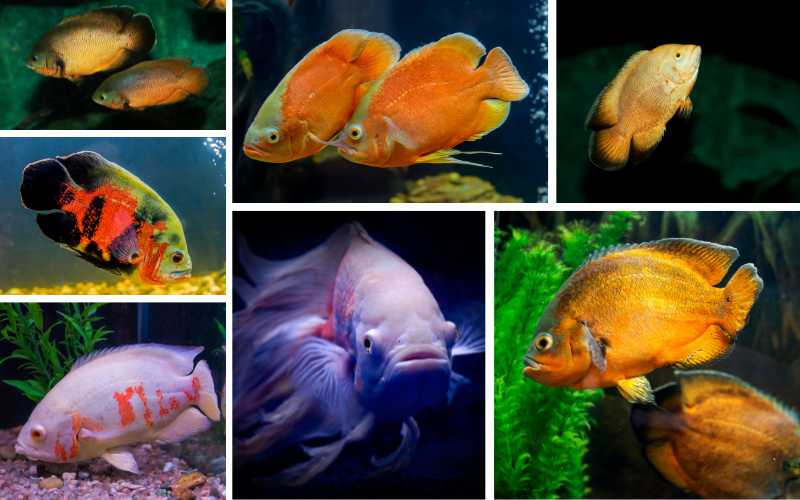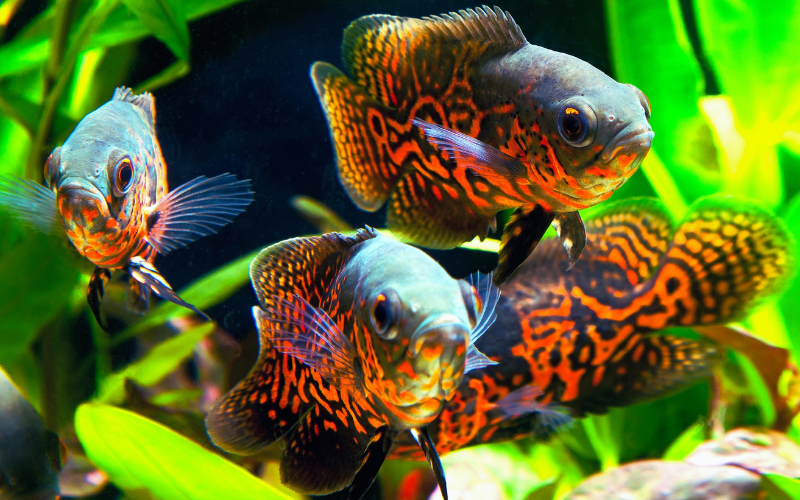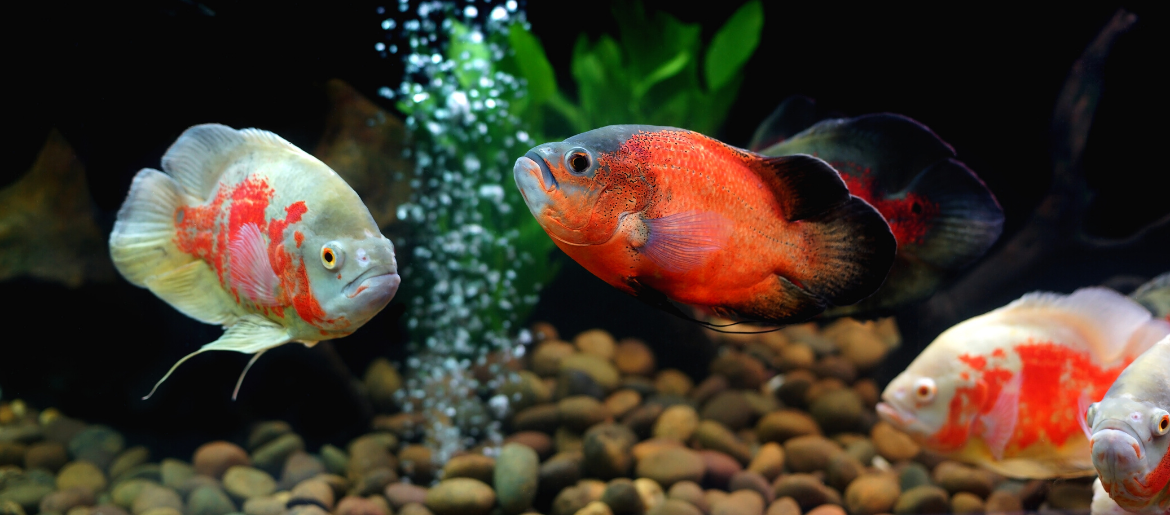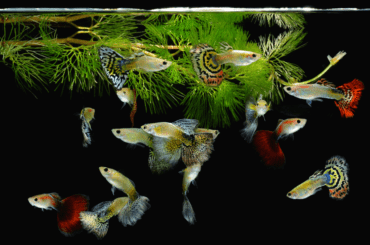If you are an aquarium hobbyist, you should have probably heard of Oscar fish. They are extremely popular and one of the staple fish in the aquarium hobby.
It’s no wonder anybody who gets an Oscar fish will eventually fall in love with them due to their personable nature. Sometimes these fish are called water puppies or wet pets as they have such great interactions with their owners.
But the problem with them being so popular is that it also makes them one of the most mistreated fish in the Hobby. So, do plenty of research before getting these loving monsters.
We hope you enjoy the content and let’s dive right in to find out how to care for Oscar fish.
Fish Overview
| Common Names | Oscar Cichlid, Marbel Cichlid |
| Origin | South America |
| Care Level | Moderate |
| Temperament | Semi Aggressive/Territorial |
| Family | Cichlid |
| Size | Up to 15 inches |
| Diet | Omnivorous |
| Required Tank Size | 75 gallons |
| Preferred PH | 6.0-8.0 |
| Preferred Temperature | 74-80 °F |
| Lifespan | 20 years |
The Oscar fish (Astronotus ocellatus) is a member of the Cichlid family which originated from the Amazon basin of South America.
They have great color combinations even at a young age and there are many different varieties. The most common is the Tiger Oscar and there’re also Red and Albino Oscars which are fairly common.
Most people say they are one of the most intelligent fish in the aquarium hobby and that they truly seem to know you. Sometimes they can even sulk and act mad due to their territorial nature. Therefore, it is sometimes difficult to find suitable tankmates for this fish.
Oscar fish Types

There are several different types of Oscar fish. Except for their color patterns, they all look pretty much the same.
The most common type is the Tiger Oscar. They’re primarily grayish-black with red or orange blotches on the body. Then there are Albino tigers which are the same as black tigers. Instead of the grayish-black color, Albino tigers have white and red.
Then there are the Red and Lutinos, which have a more consistent reddish color on their body with grayish-black color heads and fins. The Lutino Oscars are the albino version of the Red Oscar. Also, there is a special version of the Albino called Lemmon velvet.
Also, there are some variants, that are much harder to find. They are long-fin & short-body versions of the above-mentioned color patterns. But if you do, it’s truly amazing.
How Fast Do Oscars Grow?

The growth rate of Oscar fish is awesome. They grow extremely fast and first year alone, they can grow more than 8 inches. A full-grown fish can reach sizes up to 12 to 14 inches.
Some people will argue and say that they could get even bigger, but it’s only under very good conditions. With the right size tank, good clean water, and a good diet, they make a huge statement in your aquarium. We’ll talk about all of this as we go on with the list.
What’s the Best Aquarium size for Oscar fish?

When it comes to tank size, this can get a bit controversial. Normally, it is better to keep an adult Oscar in anything less than a 75-gallon tank, and actually the bigger the better.
If you are planning to keep more than a pair or some other tank mates, a 125-gallon tank or larger is the ideal tank size.
The fast growth rate of Oscar fish can lead new fish keepers to issues. Someone that doesn’t know better, could see a cute tiny baby fish at their pet store and think it could fit into a 10 or 20-gallon tank.
It will be a huge issue in less than a month or two. They do not grow to the size of their tank. Although their growth can be stunted, they will keep growing and busting out of the tank size in no time
So if you’re keeping or want to keep an Oscar fish, make sure you have a proper size tank. You’ll be rewarded with an awesome healthy fish in your aquarium.
What Makes the Perfect Tank Setup

As fish keepers, we love aquascaping and beautifully decorate our aquariums with things like plants, rocks, and driftwood.
It is awesome, but understand that your Oscars are gonna express themselves. They are downright destructive to almost any decorations that you put in the tank. They’re gonna determine where that decorative stuff goes, not you.
If you’re going to keep your Oscar fish in a 75-gallon tank, We recommend keeping decor to a minimum. Maybe do something like a nice 3D background with one focal point of driftwood or some heavy decor.
In a smaller tank, the more decor you put in means the more room you’re taking away from the fish. If you’re gonna keep them in a 125-gallon tank with plenty of room in it, maybe stick to just a couple of larger pieces of decor that the fish can’t throw around.
Although sand gives a more natural look as the aquarium substrate, Oscar fish are just fine with a bare-bottom tank or gravel as well.
What Do Oscar Fish Eat? (Diet)
Oscars fish eat almost anything you put in the tank and will probably beg you for food constantly. It’s important to have a varied diet for your fish.
The most important part is to have some type of quality floating food. It’s better to have food that has 40% to 45% of protein. Especially, go for an established brand when you purchase foods.
High-quality flakes and pellets are great for young fish while larger pellets sticks, freeze-dried krill, and frozen foods can be good for adults. Prepared food like shrimp and other frozen foods is a great treat for Oscars maybe once or twice per week.
Here is a list of varied diets for your Oscar fish,
Oscar fish are somewhat messy eaters and will produce a ton of waste. So make sure to keep up with regular water changes and ensure adequate filtration.
Normally, feeder fish are not recommended. Because they can easily bring diseases into your tank and transfer that to your fish. Otherwise, your fish could be injured itself by chasing the feeders around the tank.
Tankmates

When it comes to tank mates, whatever fits into their mouths will eventually become food for them. If you buy a tiny Oscar of the same size as other fish in your tank, you could run into problems in just a few months.
They grow at an incredibly fast-paced and most likely it’s going to be a faster pace than the other fish that are in your tank. Eventually, your Oscar fish grow larger than many of other fish, and guess what happens? The other fish become food.
Don’t buy into this idea that if an Oscar fish grows up together with other fish, they’re never going to be mean to each other. There might be some cases where it is true, but most of the time it’s not. Every time give your other tank mates a head start in growth over Oscars.
It is recommended to keep Oscar fish at the focal point of the tank. But if you absolutely need some tank mates, stick to other South and Central American cichlids. African Cichlids aren’t recommended to be mixed with Oscars. But in some cases, it could work.
Silver Dollars or Tinfoil Barbs could be great tank mates if you want some more activity in your tank. Because they are very active and swim back and forth in the tank. Here is a possible list of tankmates that can be kept with Oscar fish.
Tank Conditions (Temperature and PH)
Oscar fish are extremely hardy and capable of handling a wide range of water parameters. They can bear a PH of 6 to 8.
It’s better to set the water temperature to (78 – 80) F to keep them nice, warm, and cozy. But they do fine in water even a little cooler or warmer than that.
One of the biggest things with these fish is keeping the water clean. These fish are big eaters and big poopers. So definitely you should carry out regular maintenance.
Common Diseases
Though Oscar fish are somewhat hardy fish, they are also vulnerable to certain diseases. Keeping the water too cold, introducing new fish that haven’t been quarantined, and not keeping up with regular maintenance are the main causes that can increase the likelihood of common diseases like parasites.
But there’s another disease you’ll hear about Oscar fish called hole in the head. This is something pretty common disease for them. It has named due to the insertion of cavities and holes that develops across the fish’s head and body.
If you could identify the symptoms in the pre-stages of the disease, it is easy to treat and save your fish. The basic symptoms of Hole in the head disease are,
Basic treatments for the Hole in the head Disease
Poor water quality with high levels of nitrite or ammonia is one of the major causes of “hole in the head”. So, it’s better to start by testing the water parameters and a significant water change should be performed to eliminate the harmful compounds. Make sure the new water that is being added to the tank is at the right temperature and properly conditioned.
Another prevalent cause of the “hole in the head disease” is lack of nutrition. A good immune system necessitates a well-balanced diet. A weak immune system can be a result of Vitamin and mineral shortages. So, try to give a balanced diet with extra vitamin supplements.
At the pre-stage of the disease, antibiotics like Metronidazole, or Flagyl, are often used to treat Hexamita parasites which cause the hole in the head disease. If the lesions are more severe, we strongly recommend, taking your Oscar to a certified veterinarian for immediate treatment.
Mainly, water quality issues and possible dietary issues cause Hole in the head disease. If you do your job, you may not run into any of these problems.
Oscar Fish Breeding
Oscar fish are somewhat difficult to breed and it requires a good experience. Before talking about Breeding, you should know that Oscar fish are not the easiest fish in the world to get rid of. Because people know they’re going to grow large and to have the right setup. So, there’s a limit in terms of the market.
The first challenge in breeding is selecting a proper pair. Buying two fish that have already mated or grown up together is a workaround for that. You can breed any mix of individuals from different types when they’ve paired out.
Naturally, Oscar fish breed in the rainy season. So, by reducing the water temperature by a few degrees and performing partial water changes every 2-3 days, you may pretend them a rainy season and replicate the mating time.

After being paired out, the couple will prepare a rock surface on which the eggs will be deposited. A full-grown female can lay up to 3,000 eggs.
Until eggs hatch in 2-3days, their aggressiveness may be doubled, as they guard their eggs.
Are Oscar fish Suitable for your Aquarium?
We’ve talked about a bunch of stuff that hopefully helps you to decide whether or not to keep an Oscar fish. We’ve talked about them being fun and easy to keep. So does Oscar is a good beginner fish? Yes, but sometimes it`s no!
They can be good beginner fish because of their ability to pull through a lot of the mistakes that new fish keepers will make.
But remember that the tank size matters. Most new fish keepers aren’t going to set up a 75 or 125-gallon tank which is essential for these fish. They’re almost always going to start with a 20 or 29-gallon tank and it could be a while before they upgrade to something larger.
This goes back to us talking about Oscars being one of the most mistreated fish in the Hobby. As they grow 8 to 10 inches in the first year, you must upgrade the tank accordingly.
Oscars have the most personality of any fish. When you’ve had one for a while it’s like they recognize you. As soon as you walk into the room, they get so excited just like a cat or a dog would. It’s so sweet.
They’re also very moody. You can tell when they’re sad. You can tell when they’re happy. These fish have a lot of drama to on now.
Let’s be realistic. They recognize you as the big blurry thing that gives them food a couple of times a day. But it’s so cool to get an Oscar. You’ll know exactly what I’m talking about.





